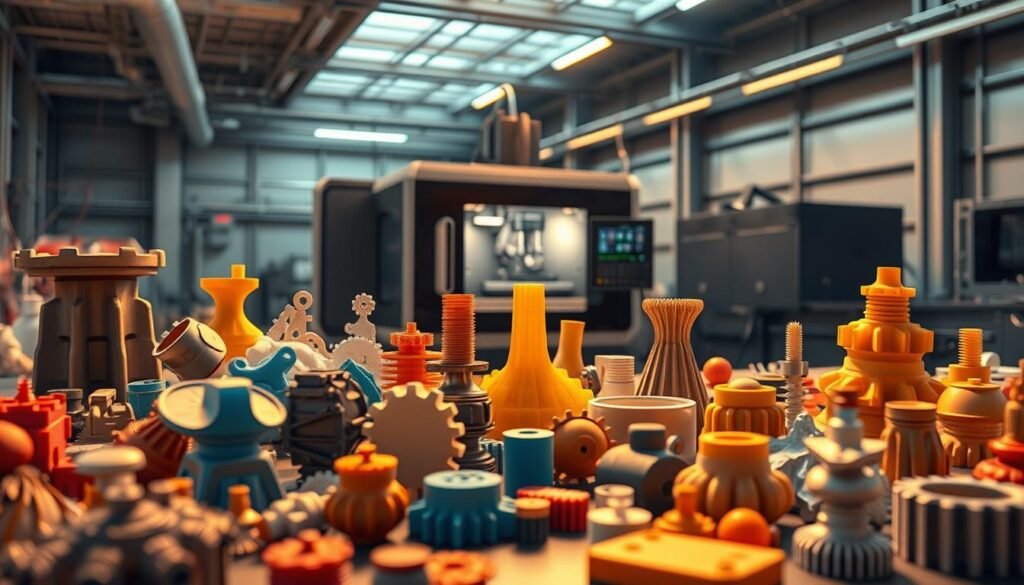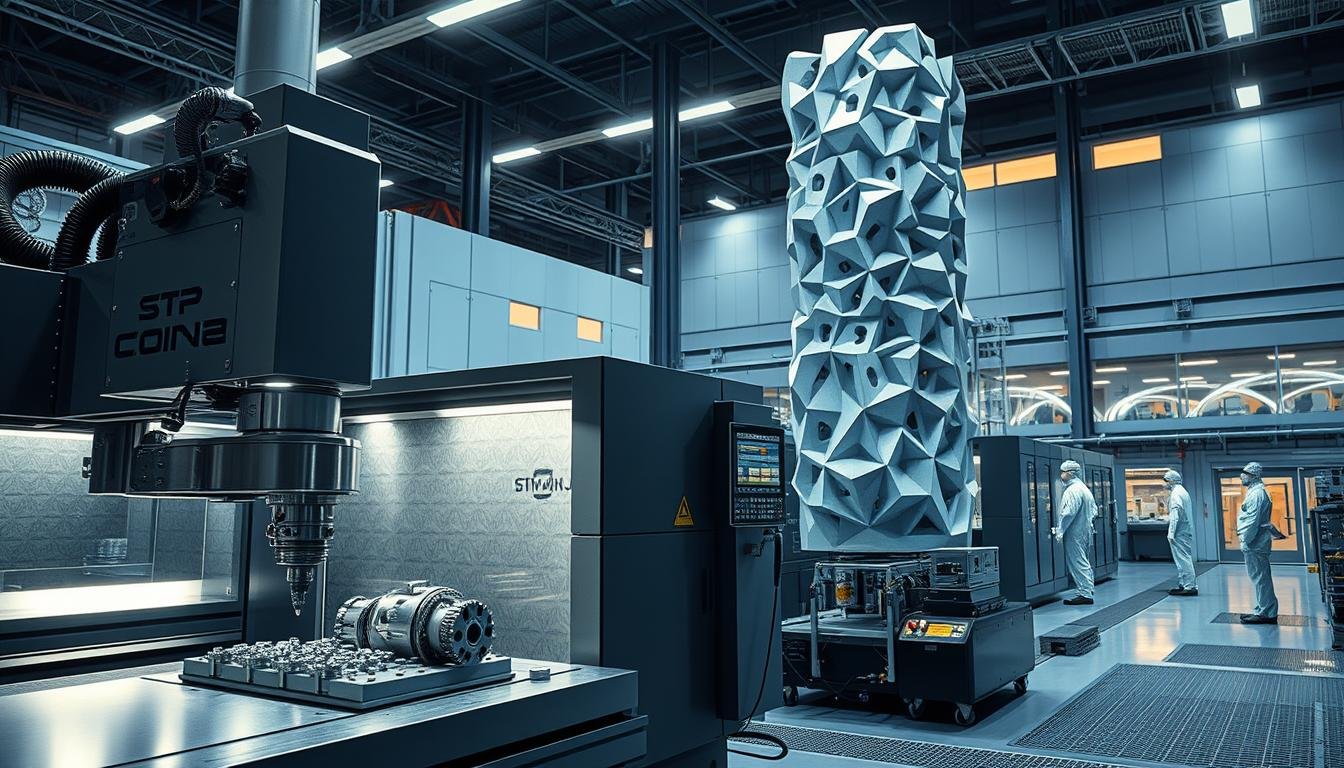In today’s world, mixing Mecanizado CNC y fabricación aditiva is a big win. Mecanizado CNC is all about taking away material to make parts. It’s super precise and is key in places like aerospace and cars.
Fabricación aditiva, on the other hand, builds parts layer by layer. It lets us make complex designs and use less material. FDM, SLA, and SLS are some top methods in this field.
When we put these two together, we get better and faster making of parts. This is a big deal in the world of Global CNC Machining Solutions.
Principales conclusiones
- Mecanizado CNC ensures mecanizado de alta precisión vital for critical industries.
- Fabricación aditiva allows for design complexity and reduced waste.
- Integrating both processes can enhance manufacturing capabilities significantly.
- Understanding each technology is key for successful implementation.
- The combination of techniques presents exciting opportunities in modern production.
Advantages of CNC Machining Over Traditional Manufacturing
CNC machining has many benefits over old ways of making things. It brings great accuracy and speed. This tech has changed many fields by offering top-notch solutions for making things.
Precisión y exactitud
CNC machining is known for its tight tolerances. This means it can make parts that are very exact. It’s great for industries that need parts that are just right.
Versatilidad de materiales
CNC machines can work with many materials. This includes metals, plastics, and even special composites. It’s perfect for different projects because it can handle so many materials.
Calidad del acabado superficial
CNC machining makes parts with amazing surface finishes. It uses special tools and programs to do this. This means parts come out looking and working great, right from the machine.
The Benefits of Additive Manufacturing

Additive manufacturing changes the game in production. It brings new ways to design, uses materials better, and speeds up making prototypes.
Design Flexibility and Complexity
Una gran ventaja de fabricación aditiva is making complex shapes. It’s hard for old methods to do this. Now, we can make things that are light and just right, without needing lots of tools.
Designers and engineers can try new ideas. They can make products that are never seen before.
Material Efficiency and Waste Reduction
Using materials wisely is key in making things today. Additive manufacturing builds parts layer by layer. This means less waste than old methods that cut away a lot of material.
While old ways use 30-50% of the material, additive can use over 90%. This saves resources and helps the planet.
Rapid Prototyping and Customization
Fast prototyping is crucial today. Additive manufacturing makes quick prototypes. This lets companies test and change designs fast.
It makes product development quick and keeps businesses ahead. Servicios CNC personalizados fit right in, meeting special needs while keeping quality high.
Global CNC Machining Solutions and Its Role in Modern Manufacturing

El mundo de la fabricación ha cambiado mucho con Global CNC Machining Solutions. Now, making things faster and better is more important than ever. This is because CNC machining companies play a big role in making things better.
They use new technologies to make things more precise and flexible. This helps make products better and faster.
How Global CNC Machining is Evolving
New technologies have changed Servicios de fabricación CNC a lot. They now use modern ways to meet market needs. Some new things include:
- Enhanced automation, making things faster.
- Improved software for design and simulation, making shapes more complex.
- More use of robotics in CNC operations, making things safer and more efficient.
Integration with Advancements in Manufacturing Technology
Modern CNC machining systems are getting smarter. They use Internet of Things (IoT) technology. This helps in many ways, like:
- Real-time monitoring of machines to make things run smoother.
- Predictive maintenance, cutting down on downtime and repairs.
- Using AI for big data analysis, helping make better production decisions.
Combining CNC Machining and Additive Manufacturing

Hybrid manufacturing mixes old CNC machining with new additive tech. This combo is super powerful. It lets us make complex shapes with less waste and more speed.
What is Hybrid Manufacturing?
Hybrid manufacturing is a new way to make things. It uses both subtractive and additive methods. This way, we can make parts that are perfect and use less material.
Advantages of Hybrid Manufacturing Processes
This method has many good points:
- It makes things faster by streamlining the process.
- It cuts down on waste by being very precise.
- It lets us make more detailed designs.
These perks make hybrid manufacturing great for staying ahead in business.
Real-World Applications and Use Cases
Many fields are using hybrid manufacturing. The aerospace industry is a big user. They make complex parts quickly and accurately.
Defense also benefits a lot. They make strong parts fast. This helps them meet market needs better.
Challenges Faced in Integrating CNC Machining with Additive Manufacturing

Combining CNC machining with additive manufacturing has big benefits. But, it also brings its own set of problems. We’ll look at the main issues, like how to join the processes, matching materials, and the cost of investing in new tech.
Process Integration Issues
Linking CNC and additive machines is tricky. It needs matching different steps, like knowing what each tech can do and how to use them together. Problems often come from different ways of working and needing special training.
Material Compatibility Concerns
Material matching is key for success. It’s important to find materials that work well with both CNC and additive methods. Different materials can cause problems, making it hard for makers to overcome these hurdles.
Investment Costs in Technology
Starting with hybrid systems is expensive. This is a big hurdle for many makers. Costs include buying machines, training, and upkeep. Knowing these costs helps companies make smart choices about their making plans. For more on costs, check out this cost analysis.
Future Trends in CNC Machining and Additive Manufacturing Integration
The future of manufacturing is exciting. CNC machining and additive manufacturing are coming together. This change is thanks to smart manufacturing and new materials.
These changes help companies stay ahead in a fast-changing market.
The Role of Intelligent Manufacturing
Intelligent manufacturing uses smart tech to make production better. It uses data and connected systems to improve how things are made. This leads to:
- Smarter choices based on data
- Flexibility in making things
- More accurate and less flawed products
Multi-material Manufacturing Innovations
Now, we can mix different materials in one thing. This makes products better and more complex. The benefits are:
- Products that do more
- Things that weigh less, saving money and energy
- Materials that meet special needs
Keeping up with CNC trends helps us use smart tech and new materials. This moves our work forward.
Practical Applications of Hybrid Manufacturing Technologies
Hybrid manufacturing technologies are becoming more popular in many fields. They help make things faster and better. This is true for the aerospace, automotive, and healthcare industries.
These technologies let companies make products quicker and with higher quality. This is a big win for businesses.
Industries Benefiting from Hybrid Solutions
In the aerospace world, hybrid solutions make parts that are both light and strong. This is key for today’s planes and spaceships.
For cars, hybrid manufacturing means making complex designs fast. This leads to better cars. In healthcare, it’s all about making custom implants and tools for patients.
Case Studies in Aerospace and Medical Devices
There are many examples of how hybrid tech changes things. In aerospace, big names use it to make rocket parts. They mix 3D printing and CNC machining for parts that meet tough standards.
In medicine, hybrid tech is changing how implants and tools are made. It offers great accuracy and customization. For more info, check out this source.
| Industria | Aplicación | Beneficios |
|---|---|---|
| Aeroespacial | Lightweight rocket components | Improved performance, reduced weight |
| Automoción | Prototype vehicle parts | Faster development, enhanced design |
| Sanidad | Custom medical implants | Personalized solutions, improved patient outcomes |
Cost Implications of Combining Technologies
Mixing CNC machining and additive manufacturing is a smart move for saving money. It helps leaders plan better and use resources wisely. This part talks about how to save money and plan budgets for these new techs.
Cost Savings Through Efficiency
Using both additive and CNC techs can cut down on costs a lot. Companies waste less material, which saves money. This combo helps make more stuff with less spending.
Budgeting for Hybrid Manufacturing Projects
Planning for hybrid projects needs smart budgeting. It’s key to look at how much money you’ll make back from these techs. You must think about the cost of starting up, labor, and materials to make a solid budget.
| Factor de coste | CNC Only | Additive Only | Fabricación híbrida |
|---|---|---|---|
| Inversión inicial | Alta | Variable | Optimizado |
| Costes laborales | Higher due to specialized skills | Baja | Balanced |
| Material Savings | Moderate waste | Significant waste reduction | Maximized efficiency |
| Production Cycle Time | Estándar | Quick for small runs | Reduced overall time |
For more info on money matters, check out este enlace. It dives deep into CNC costs.
Conclusión
CNC machining and additive manufacturing together change the game in making things. They make things more precise and efficient. This helps many industries grow and improve.
Using both methods, companies can meet today’s high production standards. This leads to better performance overall. It’s key to stay ahead in a fast-changing market.
Looking into Global CNC Machining Solutions can help companies improve. For more info, check out Servicios de mecanizado CNC de Mekalite.
We’re dedicated to providing top-notch manufacturing solutions. By combining CNC and additive manufacturing, industries can explore new possibilities. This opens up new ways to make things better and more flexible.
PREGUNTAS FRECUENTES
¿Qué es el mecanizado CNC?
CNC machining uses computer systems to cut and shape materials. It makes detailed parts for industries like aerospace and cars.
What are the benefits of additive manufacturing?
Additive manufacturing is flexible and efficient. It makes complex shapes and uses less material than old methods.
How is addressing global CNC machining solutions vital for modern manufacturing?
Global CNC solutions keep improving with new tech. They work with automation and smart systems, making things faster and easier to track.
What is hybrid manufacturing?
Hybrid manufacturing mixes additive and subtractive methods. It makes parts faster and uses less material, offering more design options.
What challenges do manufacturers face when integrating CNC machining with additive manufacturing?
Integrating these methods is hard. It involves matching materials and dealing with high costs of new systems.
What future trends can we expect in the integration of CNC machining and additive manufacturing?
We’ll see more smart manufacturing and automation. New materials could also improve product performance.
Which industries stand to benefit from hybrid manufacturing technologies?
Aerospace, automotive, and healthcare will gain. Hybrid tech cuts down on time and boosts quality.
What financial aspects should decision-makers consider when adopting hybrid manufacturing?
Look at how it saves money and reduces waste. Plan your budget well to see if it’s worth it.


